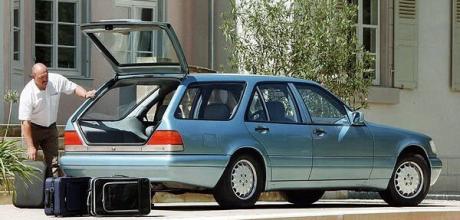Mercedes-Benz S-Class Estate W140
Mercedes-Benz has never manufactured its own S-Class Estate, however it has let other companies create their own versions for wealthy clientele, as Ian Kuah recalls
While almost all car enthusiasts are fans of supercars, for most people the practical head has to rule the passionate heart, which is why the Audi RS6 Avant has always been a best seller.
On the practical side, the demise of the Volvo 900 series estate in 1998 left the door wide open to the E-Class T-model to take the crown as the most commodious load carrier on the market. The trick was covering the high performance and load carrying bases, which the AMG E63 S 4Matic+ Estate did when it debuted in 2016.
Cars tend to grow with each generation, and the W213 E-Class saloon is as large as the W126 S-Class from the 1980s, albeit smaller than the substantially larger W140 S-Class that replaced it in 1991. While many wealthy buyers might have liked an S-Class T-model, because the estate car or station wagon was viewed as a ‘working car’ back in the 90s Mercedes would never have sullied the image of its flagship limousine this way. Instead, it gave its consent to Cadform and Binz to design and build 100 S-Class T-models for wealthy customers who had been banging on its doors.
The prototype vehicle shown in the 1995 Cadform sales brochure was based on the standard length S500, which was strange since the LWB version would have been even more capacious with the rear seat backrests folded flat. It would also have been better proportioned, as the rear doors (which are shorter than the front doors) of the standard W140 have always looked rather awkward to my eyes. Nonetheless, the resulting vehicle was exactly what the customers wanted, and when AMG entered the frame things became really interesting.
In the mid 1990s, the Sultan of Brunei and his youngest brother, HRH Prince Jefri were always on the lookout for unusual cars to add to their massive and growing collection. A practical counterpoint to the eight 300SL Gullwings and three 300SL Roadsters they had converted with 380bhp SL60 AMG underpinnings, the S-Class T-model had its own appeal in V12 form as the AMG S73 T with suitably fettled mechanicals, wheels and bodywork. It was no surprise that the 10 cars made for Brunei were based on the long wheelbase S-Class, which gave them better proportions.
I had the chance to examine a grey example when I was invited to Brunei in late 1997 and was very impressed by the fit and finish. Everything was up to Mercedes production standards, from the panel finish and gaps to the quality and fit of the carpet in the rear cargo compartment. The tailgate bore the badge ‘Brunei’ on the left and ‘555’ referring to the engine power on the right, with angled AMG flashes proceeding each. The 19-inch AMG alloys and one-inch lower sport suspension gave the car a much more purposeful stance than the car in the Cadform/Binz brochure.
When I drove the W140 S600 on the 1991 press launch in the South of France, the 5,987cc M120 V12 boasted 402bhp. By the time AMG launched its M297 E72 motor derived from the M120 V12 for the 1996 model year, the output of the base motor had fallen to 389bhp with 420lb ft of torque due to tighter emission regulations.
In that pre-turbocharged engine era, extra power and torque often came from a displacement bump along with hotter cams and other tried and tested tuning engine methods. AMG’s E72 motor displaced 7,055cc from a nearly square bore and stroke of 91.0x90.4mm versus the oversquare 89.0x80.2mm stock dimensions. Output was 518bhp at 5,900rpm with 546lb ft of torque at 4,000rpm. While compression ratio remained unchanged at 10.0:1, AMG recommended the use of 98 Octane fuel to support the more aggressive ignition timing that delivered better throttle response and low-end torque.
The 10 Brunei cars used the next evolution of the M297 motor with the bore and stroke further increased to 91.5x92.4mm for a swept capacity of 7,291cc. This helped increase output to 547bhp (555hp) for the S73 T. In the end, AMG built 18 of these cars, 10 of which were destined for Brunei. The last few cars built featured the SEC Coupe nose, but having seen a black example at AMG in Affalterbach in 1998, I have no doubts that the saloon front is a much better fit for the estate car rear. When Prince Jefri’s company Amadeo collapsed in 1998 and he was sanctioned by the Sultan, the last of these cars and the SL60 Gullwings were left at AMG. As all were right-hand drive, their market was limited to the UK and some Far Eastern countries. One of the Gullwings ended up with the Sultan of Johor, who is also a car enthusiast.

Everything was up to Mercedes standards, from the panel gaps to the quality of the boot carpet.Cadform’s wonder wagon was based on an SWB S500 V8 saloon. Cadform and Binz extended the 140’s roof. 7.3-litre V12-powered AMG with a coupe’s nose.


